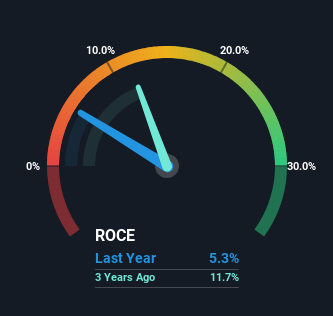- South Korea
- /
- Auto Components
- /
- KOSDAQ:A024840
Returns On Capital At Kbi Metal (KOSDAQ:024840) Have Stalled
To find a multi-bagger stock, what are the underlying trends we should look for in a business? Amongst other things, we'll want to see two things; firstly, a growing return on capital employed (ROCE) and secondly, an expansion in the company's amount of capital employed. If you see this, it typically means it's a company with a great business model and plenty of profitable reinvestment opportunities. However, after investigating Kbi Metal (KOSDAQ:024840), we don't think it's current trends fit the mold of a multi-bagger.
Return On Capital Employed (ROCE): What Is It?
For those who don't know, ROCE is a measure of a company's yearly pre-tax profit (its return), relative to the capital employed in the business. Analysts use this formula to calculate it for Kbi Metal:
Return on Capital Employed = Earnings Before Interest and Tax (EBIT) ÷ (Total Assets - Current Liabilities)
0.053 = ₩7.1b ÷ (₩252b - ₩118b) (Based on the trailing twelve months to March 2024).
So, Kbi Metal has an ROCE of 5.3%. In absolute terms, that's a low return and it also under-performs the Auto Components industry average of 8.5%.
Check out our latest analysis for Kbi Metal

While the past is not representative of the future, it can be helpful to know how a company has performed historically, which is why we have this chart above. If you're interested in investigating Kbi Metal's past further, check out this free graph covering Kbi Metal's past earnings, revenue and cash flow.
What The Trend Of ROCE Can Tell Us
The returns on capital haven't changed much for Kbi Metal in recent years. Over the past five years, ROCE has remained relatively flat at around 5.3% and the business has deployed 34% more capital into its operations. Given the company has increased the amount of capital employed, it appears the investments that have been made simply don't provide a high return on capital.
Another thing to note, Kbi Metal has a high ratio of current liabilities to total assets of 47%. This effectively means that suppliers (or short-term creditors) are funding a large portion of the business, so just be aware that this can introduce some elements of risk. Ideally we'd like to see this reduce as that would mean fewer obligations bearing risks.
The Key Takeaway
In summary, Kbi Metal has simply been reinvesting capital and generating the same low rate of return as before. Although the market must be expecting these trends to improve because the stock has gained 71% over the last five years. Ultimately, if the underlying trends persist, we wouldn't hold our breath on it being a multi-bagger going forward.
If you'd like to know more about Kbi Metal, we've spotted 4 warning signs, and 2 of them are a bit concerning.
For those who like to invest in solid companies, check out this free list of companies with solid balance sheets and high returns on equity.
Valuation is complex, but we're here to simplify it.
Discover if Kbi Metal might be undervalued or overvalued with our detailed analysis, featuring fair value estimates, potential risks, dividends, insider trades, and its financial condition.
Access Free AnalysisHave feedback on this article? Concerned about the content? Get in touch with us directly. Alternatively, email editorial-team (at) simplywallst.com.
This article by Simply Wall St is general in nature. We provide commentary based on historical data and analyst forecasts only using an unbiased methodology and our articles are not intended to be financial advice. It does not constitute a recommendation to buy or sell any stock, and does not take account of your objectives, or your financial situation. We aim to bring you long-term focused analysis driven by fundamental data. Note that our analysis may not factor in the latest price-sensitive company announcements or qualitative material. Simply Wall St has no position in any stocks mentioned.
Have feedback on this article? Concerned about the content? Get in touch with us directly. Alternatively, email editorial-team@simplywallst.com
About KOSDAQ:A024840
Kbi Metal
Engages in the metal and automotive electronical parts businesses in South Korea.
Good value with mediocre balance sheet.
Market Insights
Community Narratives





